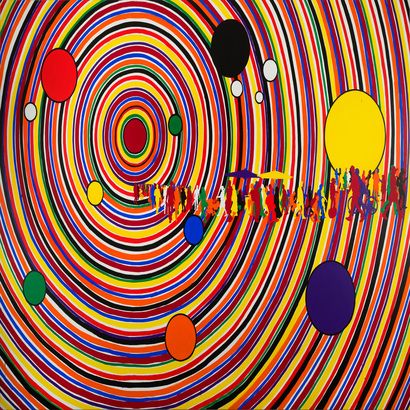The Sun at the Marmottan Museum: Monet and the others
To resituate the context of this exhibition and its background, it was initiated around the celebration of the 150th anniversary of the painting "Impression, Sunrise" by Monet.
53 lenders have allowed this exhibition to live to present a hundred works stretching from the ancient period to today.
The first part of the exhibition is dedicated to ancient art and measuring instruments from the Paris Observatory, highlighting - no pun intended - the evolution of astronomy that has deciphered the mysteries of the Sun over time.
The painting "Impression, Rising Sun" appears as the median cursor, announcing the modern period during which modern and contemporary artists will return to symbolic or poetic approaches.
Let's start with the initial motif of the exhibition: Monet's painting "Impression, Rising Sun".
A sketch executed quickly to capture the atmospheric moment, it was catalogued under the title "Impression: Rising Sun" when it was exhibited in 1874 in the first exhibition of the group, described simply as the Société Anonyme des Artistes-Peintres.
While his elders worked in the studio from sketches, Monet went further and painted directly on the spot
This painting is credited with inspiring the name of the Impressionist movement.
The sun is undoubtedly the focal point of the composition of this painting, dominating the composition with a clean drawing in warm tones, contrasting with the humid atmosphere of the harbor bathed in mist.
Believe it or not, researchers have tried to determine whether this sun was rising or setting...
Although this does not add anything to this painting, we know for sure that the painting dates from November 13, 1872 at 7:35 am, 30 minutes after dawn.
Claude Monet painted this canvas in a few hours, from the room of his hotel on the Southampton Quay. He did not know then that it would mark a real turning point in the History of Art!
This raises questions about the representation of the setting or rising sun and the way in which artists have approached this problem.
It would seem that Gérard Fromanger did not seek the moment but the Sun as dominant in this painting "The Sun floods my canvas" dated 1966.
The exhibition is then divided chronologically into several paintings, taking up the theme of the sun as a common denominator, according to the seasons and the imagination of the artist: André Derain in a pointillist painting, Camille Pissarro who combines the sun in a snow effect in View of Bazicourt, Felix Valloton or Paul Signac.
A favorite is this painting by Valdemar Christian Schonheyder Moller: Sunset in Fontainebleau in 1896.
A modern painting by this Danish artist: a spectacular painting in which the sun is staged through a curtain of trees. The powerful sun breaks through and the glare is translated by the presence of a slightly yellowed white halo.
One could almost believe in an overexposed photographic print.
Observe this evanescent sun in the black center, in eclipse witnessing a crucifixion staged by Franz Von Stuck dated 1906. The dramatic moment of the scene is carried by the sun in a glowing halo, symbol of the blood of Christ, and a pink sky symbol of his suffering which Heaven and Earth are witnesses. The painter associates this theme of the Passion with the phenomenon of the eclipse which increases the pathos of the scene: the half-light is almost supernatural, as if the divine was witnessing this scene. A relationship between the birth of Christ and the sun.
In another style: the blazing and radiant sun in this painting by Otto Dix, where we could see an influence of Van Gogh - a gray painting, dark, desperate, pictured by the birds of doom, harbingers of disaster combined with the sun, symbol of hope.
In a positive repertoire, Sonia Delaunay proposes a study of the sun in its contrasts through the study of sunlight, its spectrum and its effects on vision. The contours are broken, making the shapes disappear in favor of colored planes.
A discovery: this painting by Vladimir Baranov-Rossiné who superimposes his Nymphs and Centaurs in a tangle of circles in a spectrum of colors, like a futuristic machine in a solar system, symbol of man subjected to the cycle of the sun.
A beautiful set of sculptures by Calder, coupled with a painting by Miro "Woman and Bird" which belongs to a set called "Constellations
Elodie Couturier, Expertisez.com
Subscribe to our channel to not miss any news : expertisez youtube
Subtitles in English


